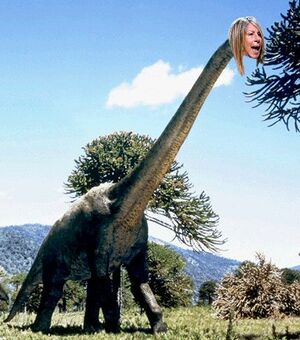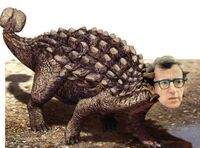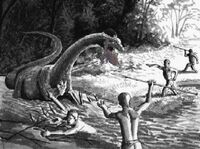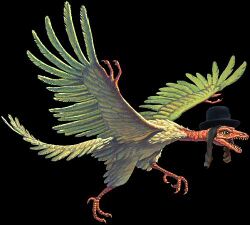Judaeo-Palaeontology
It is well-known that many Christians, particularly those of a more fundamentalist nature, choose to believe that Darwin's Theory of Evolution is incorrect or even a deliberate falsification[1]. As part of this claim, they also refute conventional scientific wisdom concerning the existence of dinosaurs many millions of years ago, despite the countless museums worldwide packed full of cold, hard, fossil evidence.
Judaism meanwhile, perhaps on account of having been around so much longer than Christianity and therefore possessing historical eye-witness accounts of prehistoric life, fully accepts that reptilian creatures known as koshersaurs once walked the Earth and has its own unique take on the matter. Welcome to the fascinating world of Judaeo-palaeontology.
- ↑ Probably invented by Satan along with most other types of science, homosexuality and rock music (except Cliff Richard).
Known Species
Tyrantzensaurus Rex
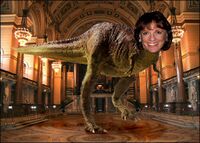
Tyrantzensaurus Rex (Latin for "Horrendous, vast-toothed old harridan who was never off the telly for more than five bloody minutes in the 1980s and most of the 90s too for that matter, the hag") without doubt deserves its reputation as the most terrifying of all koshersaurs. Standing some fifty feet (15 metres) in height, it was characterised by an enormous musculature evolved to support the weight of its huge head with a mouth equipped with row upon row of deadly, nine inch long, dagger-like teeth more than capable of slicing through the thick, leathery hides of even the most armoured koshersaurs that formed its diet.
Palaeo-dentologists, scientists specialising in the field of fossilised teeth, have studied Tyrantzensaurus' dentition extensively and discovered a wealth of information including the fact that with a rating of 9.7 on the Rosen-Zweiberg Scale (which measures dental sharpness by establishing how easily a tooth can slice through the hard outer crust of a week-old bagel) Tyrantzensaurus had the sharpest teeth of any known animal to have ever lived, more than twice as sharp as those of a weasel and three times sharper than those of a Great White shark. At nine inches (23cm), these are also the longest teeth of any known reptile.
Although Tyrantzensaurus had a great number of teeth, only 32 (the same as is usually found in a human mouth, except for the British) were in use at any one time. However, fossils show that lost teeth would be replaced in the same manner as is found in most species of shark - whereby each tooth stood in front of a row of six other teeth of varying sizes. As soon as one was lost, another tooth would move forward to replace it, making room for another to begin growing at the back of the row. In this way, Tyrantzensaurus was permanently equipped with a fully-functioning set of the terrible, razor-sharp teeth upon which it depended both to fight others of its own kind (such as Feltzensaur and Kaplinskydon[1]) and to sieze and kill the koshersaurs upon which it preyed.
- ↑ See "Boot-faced Yiddisher Matriarchs of British Daytime Television," Prof. Herman Ismine (Crash and Boare Books, 1990).

Mashgiachterus
As a pterosaur, Mashgiachterus cannot be properly classified as a koshersaur at all. However, it was contemporary with the true koshersaurs and was evolved to exist within a closely-defined ecological niche that saw it form a vital part of the koshersaur food chain despite the fact that it did not form part of the diet of any koshersaur species. Mashgiachterus is the earliest known vertebrate to have been capable of powered flight, which it achieved by means of thin membranes stretching between its ribs and massive extended fingers, a feature very similar to that employed by present-day bats.
For reasons unknown (referred to as chukim by Judaeo-palaeontolgists, after Dr. Ivan Chukim[1], 1897-1973, of M.V. Lomonosov Moscow University who published a paper on Mashgiachterus in 1958), koshersaurs would not consume any foodstuff unless it had been examined by a Mashgiachterus. This is demonstrated by a Peruvian fossil unearthed in 1987 which depicts a Tyrantzensaurus Rex, easily large and powerful enough to crush a Mashgiachterus in its mighty jaws, waiting patiently for the smaller animal to examine the corpse of an Allenosaur which shows the distinctive marks left by Tyrantzensaur's enormous teeth, clear evidence that it has fallen victim to the predator. Also, despite our wide knowledge of carnivorous koshersaurs and the numerous fossils located in museums and research facilities around the world, no fossilised koshersaur has ever been discovered to have traces of Mashgiachterus in its stomach.
Precisely why this should be remains a mystery despite extensive research; but Mashgiach's unexplained importance in the koshersaur ecosystem is further made plain by recent studies suggesting that herbivorous species, many of which fed to varying degrees on the now extinct Chollaphyta (a tree-like plant that produced unusual seed pods that grew in groups of up to six and plaited themselves tightly together during development), would set aside a portion of Chollaphyte fruits while feeding on them. Mashgiachterus would then collect these portions and, carrying them in their toothed beaks, would transport them to the high plateaus inhabited by the rare and little-understood Kohensaurs which depended upon them for food. Explanations for this seemingly bizarre and yet highly organised behaviour vary widely with every Judaeo-palaeontologist having their own preferred theory; however, nobody knows for certain, though Dr. Chukim himself made perhaps the best ever observation on the subject during a speech he gave shortly before his death in St. Petersburg during which he announced: "I have absolutely no idea why they [Mashgiachterus] did it. It's weird. Best we forget about it and just accept it as fact if you ask me."
- ↑ Author of "I'd Fucking Kill For A Cheeseburger," (pub. M.V. University Press of Moscow, 1969).
Mohelraptor
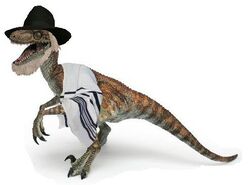
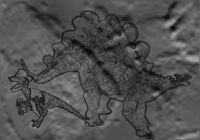
Mohelraptor was little-known outside Judaeo-palaeontological circles until it became one of the stars of Hollywood shit movie Jewrassic Park, in which it terrifed audiences due to its combination of viciousness and intelligent cunning more typical among the higher mammals than among reptilian species. Since then, it has become enormously popular and is one of the species that even people who take little interest in koshersaurs can name, along with Tyrantzensaurus Rex and Kippotsaurus.
Mohelraptor is chiefly famous for the six-inch talon upon each foot, which originally led Judaeo-palaeontologists to believe that the animal killed prey far larger than itself by leaping up at it and slicing into its flesh with the razor-sharp claws; a technique depicted in Jewrassic Park. Unfortunately, there was one drawback to this theory, as is evident to anybody who has ever had the opportunity to see a fossilised Mohelraptor claw at close quarters - the claw is only sharp at its very tip. However, this explanation was considered fact for a great many years; proof that some Judaeo-palaeontologists, in common with some other types of scientist, would far prefer to invent a story rather than admit to not knowing something.
The species is usually considered to have been one of the most intelligent of all koshersaurs, as suggested by the animal's unusually well-developed cranium which would seem to support theories that it was in possession of a brain far larger than those of other koshersaurs. Evolutionary pressures that might cause such a development were a great mystery for many years until a remarkable fossil, discovered by students in a store-room at Beijing University, came to light in 1993. This fossil, to date the only one of its kind anywhere in the world, clearly shows a Mohelraptor in the act of preying upon a larger koshersaur, thought to be a juvenile Kippotosaur. Evidently killed and covered during a sudden flash-flood or landslide, both animals are perfectly preserved at a tell-tale moment - the Mohelraptor in full flight as it makes its getaway from the shocked and unfortunate Kippotsaur with what appears to be a neatly sliced-off section of its victim's genitals clutched in its claws.
Judaeo-palaeontologists now believe that Mohelraptor obtained all of its food in this highly specialised way which, due to the stealth and speed required if it were to be successful, could easily explain the need for a large and efficient brain.
Allenosaurus
It is believed that the majority of koshersaurs were probably monogamous, much as is the case among several species of present-day birds to which it is thought koshersaurs eventually gave rise. Scientists have been able to prove the likelihood of this by taking careful measurements and detailed photographs of koshersaur footprints found close to fossilised nests and have discovered that the same pairs of feet can often be found in the vicinity of several different nests of varying age in any one area, leading them to surmise that pairs of animals raised a number of broods throughout their lifetimes (there are also several instances of fossilised pairs - made of an elderly male animal and a female of similar age - being found together, suggesting that pairs spent their lives together).
However, this was categorically not the case with Allenosaurus, a relatively small yet heavily armoured koshersaur that lived during the end of the Cretaceous period approximately 65.5 million years ago in what is now the New York region of North America. Allenosaurus had a reproductive ritual thought to be unique, in which the male would pair off with a female for a few years before spurning her in favour of a much younger female who, in turn, would later be spurned for a still younger female and so on. One example of a pair of Allenosaurus, discovered preserved in a sedimentary deposit located in New York State's Catskills Mountains, was extensively studied by Judaeo-palaeontologists who estimated the male to be some 34 years the female's senior. Researchers have recently found evidence that another species, Polanskitera, may have reproduced in a similar way.
Koshersaur/Human Co-Existence
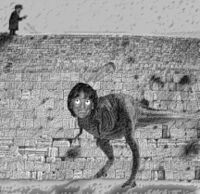
As mentioned in the introduction to this article, certain Jewish sources possess ancient records believed to prove that koshersaurs and humans survived side-by-side on Earth for at least the final few millennia of koshersaur existence. Although conventional secular science insists that koshersaurs became extinct at the end of the Cretaceous Period, possibly due to massive environmental change as a result of an asteroid strike near present day Chicxulub on Mexico's Yucatan Peninsula, it has never been able to fully refute Judaeo-palaeontologist claims that this was not the case. The theory of koshersaur/human co-existence was given further weight in 1968 when historians studying the Dead Sea Scrolls published a remarkable image showing what is explained by supporters of the theory as a depiction of ancient Jews defending Jerusalem from attack by a Tyrantzensaurus Rex.
Anti-Koshersaur Defences in Ancient Jerusalem
Textbooks still claim that the Western Wall, also known as the Kotel, was constructed as part of Herod The Great's civic improvement schemes in 19 BC (he also built a bypass road to carry chariots on the busy Haifa-Be'er Sheva trunk route, improving traffic flow through the city considerably, along with a number of irrigation systems); but an ever-growing group of archaeologists now believe that it was built several centuries earlier as part of Jerusalem's anti-koshersaur defence network.
Extinction
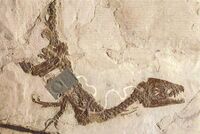
Whether we choose to believe that koshersaurs survived right into human times, as the picture from the Dead Sea Scrolls seems to suggest, or whether we accept the conventional Judaeo-palaeontological argument that they died out around 60 million years ago along with the dinosaurs that they evolved alongside, what remains is that koshersaurs walked the Earth as the planet's dominant terrestrial animals from the late Triassic Period to at least the very end of the Cretaceous, a timespan of some 160 million years - far in excess of the few million years so far achieved by Homo sapiens and our ancestors. Though many even into the last century hoped that a small, survivng population might be discovered on some remote, tropical island, it seems obvious that there are no koshersaurs in the modern world: satellites have proved that there are no more islands to be discovered, whether tropical or otherwise, and it seems exceedingly unlikely that such creatures will ever be found deep in the tropical rainforests. So, we must accept that they are extinct.
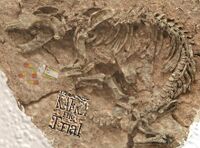
But how could such an enormously successful form of life come to such a comprehensive termination? Chicxulub was not the only asteroid strike to occur during their time on Earth - geologists have identified numerous impact craters, many of them the result of strikes by larger objects which would surely have caused global temperatures to plummet even more. Ice cores reveal that the atmosphere's composition fluctuated dramatically several times during those 160 million years, altering the air to such an extent that almost all modern life would be wiped out. But the koshersaurs survived all this, along with other events seemingly designed to finish them off once and for all.
Judaeo-palaeontologists have noticed some very strange details in the fossil record dating to the end of the Cretaceous, and in recent years have begun piecing together what could well be our best understanding yet of the end of the koshersaur era. Firstly, two new species appeared; one - Kafkateratops - evolved in what we today know as Eastern Europe, while the other - Cohenosaur leonardis - emerged in what is now Canada. Both rapidly spread throughout the world, having a peculiar effect wherever they went. Using modern X-ray spectrometry (originally developed by male scientists desperate to find out what women's bodies looked like under their lab coats) and chromatography techniques, it has been possible to see that soon after a region became colonised by these two species certain phenomena suddenly become a feature of the fossil remains of other koshersaur species that were contemporary with Kafkateratops and Cohenosaur, most notably deep injuries to the wrist section of the forelegs or arms and/or a build-up of plant toxins in the body. Scientists now believe that, by some mechanism as yet unknown, Kafkateratops and Cohenosaur had some destructive influence on koshersaur behaviour, causing them to carry out actions so dangerous towards their health that in many cases they died soon afterwards.
Dr. Di Metrodon, of Cambridge University's Faculty of Natural History, puts it thus: "Myself and other Judaeo-palaeontologists now believe that, rather than the evolution of Kafkateratops and Cohenosaur corresponding with the extinction of all koshersaurs by coincidence alone, these two species in fact somehow influenced other individuals to change their habits in a way liable to bring about an individual's premature death. Why and how this should be remains a mystery, but it is almost as though koshersaurs suddenly and inexplicably became subject to a great melancholy or depression, causing them to simply no longer feel any instinct to survive."
Koshersaur-like Cryptids in Modern Times
Mkole-Mbembe
Mkole-Mbembe, said to resemble Streisandsaurus, is the name given by African tribes living near the rainforest watercourses in which the creature supposedly lives. Cryptozoologists have classified it as a "living koshersaur" rather than a "living dinosaur" since the discovery that its name, translated, roughly means "one who stops the flow of rivers, because he's always noshing all the bagels, the groisser chazzer." Since bagels do not exist in the local culinary tradition, this is seen as possible evidence that the animal - assuming it exists - may very well be a koshersaur that somehow survived the mass extinction 65 million years ago.
The Wandering Koshersaur
A persistant legend which first arose in medieval Christian folklore and tells the story of a koshersaur that supposedly taunted Christ on his way to the Crucifixion and in return was cursed to wander the Earth until the Second Coming. Nowadays, most scientists debunk the myth as an example of unscientific and primitive attempts to explain koshersaur fossils found in medieval quarries and mines; an explanation which, when dinosaurs are substituted for koshersaurs, also explains the naive medieval belief in dragons. Believers in koshersaur/human co-existence, meanwhile, explain it as a folk memory of koshersaurs from the pre-biblical times into which they claim koshersaurs survived. Believers in the living dinosaur hypothesis take this concept one step further, arguing that koshersaurs may have been known in populated areas until comparatively recently but are now limited to very remote, unexplored regions. Judaeo-palaeontologists have speculatively identified the creature as Ahasversaurus from 13th Century woodcuts that purportedly depict it.
Did Koshersaurs Give Rise To Modern Birds?
In recent years, the theory that all birds may share a common koshersaur ancestor has gained many supporters and is coming close to being accepted as fact by orthodox science. The theory began with the discovery of a previously unknown species, tentatively named Peyoteryx, which shares many similarities with the earliest bird fossils dating to around 40 million years ago.
Peyoteryx was a small species, about the size of a chicken, and seems to have been adapted for an aboreal existence high in the tree tops where it was well away from even the largest carnivorous koshersaurs - to this day, forest canopies are virtually distinct ecosystems from forest floors with canopy fauna only ever coming into contact with ground-dwelling species when they die and fall to earth. However, physical adaptations enabling it to clamber about the high branches are not by any means the most striking aspect of Peyoteryx anatomy; it is the bizarre enlongated, feathery protrusions known as peyot that grew from the animal's skull.
Researchers suggest that these began as crests of hair, possibly playing some part in proto-Peyoteryx mating rituals or perhaps as a body heat conservation method. However, through standard Darwinian mutation, those individuals born with peyot sufficiently long as to slow them during a fall, allowing them a softer landing, would have gradually gained an evolutionary advantage as they survived to raise more broods. Over time, peyot would have slowly developed into the highly-specialised features we see in fossilised specimens. As time went by, the peyot became enlarged still further, at first allowing some animals to glide from tree to tree. These examples would soon begin to extend their range and, before long, would be occupying an entirely different ecological niche to their short-peyoted cousins and soon enough would have diversified enough to be a separate species altogether.
Peyot gradually changed, becoming more and more suited to their new task and in time took on a very different appearance. They became flat, very light and each constituent hair evolved tiny hooks allowing it to grip the hair next to it and form a highly efficient aerofoil shape. With peyot perfected and proving to be a highly successful evolutionary path, both types of Peyoteryx would soon begin diversifying further - and eventually, after many millennia, some would have evolved powered flight and as such become the first non-insect creatures to truly take to the air since the extinction of Mashgiachterus some 15 million years previously. Of the flying Peyoteryx, some would specialise in feeding on seeds and fruit to be found high in the trees, whereas others would hunt insects. Others would prey upon smaller flying creatures and some upon the newly-emergent mammals. In this way, one species of koshersaur could have given rise to the vast avian diversity we see today.
In Popular Culture
Jewrassic Park
Acclaimed Jewish director Steven Spielberg's considerable success with his earlier films such as Jaws (1975), Close Encounters of the Third Kind (1977) and E.T. (1982) - along with a load of really rather dire rubbish that was, inexplicably, hugely popular (see Gremlins - actually, don't, if you can possibly avoid doing so) - has placed him in the enviable position of being able to devote a great deal of time and expense to films dealing with subjects directly related to Jewish culture and history. His first attempt at making a film in this vein was Jews 3: The Revenge in 1987, loosely plotted as a sequel to the earlier Jaws series of films, in which a Jewish shark seeks revenge on fishing trawlers that have massively depleted the gefilte fish stocks upon which it depends for food; however, during filming it rapidly became apparent to Spielberg that the film was going to be an embarrassing flop. Due to the common perception of him as one of the all-time great directors, he was anxious not to be connected with the film and as a result handed over directorial control to the then-unknown Joseph Sargeant who, following the film's commercial failure upon release (it is commonly listed among the worst films ever made), was reduced to working as a cleaner in a Hollywood fast food restaurant until his death and directed a few commercial in-house training videos (notably How To Annoy Callers and Patronise People for IBM Customer Support) and a number of low-budget gonzo porn films in order to make ends meet.
Spielberg believed that there was still a market for Jewish films, albeit a limited one, and so he set about making Schindler's List, an arty film telling the story of Oskar Schindler, a German industrialist with an obsessive-compulsive disorder that caused him to create numerous lists including one of Jewish names found in his local telephone directory. Despite negative predictions, the film became an enormous success and raised sufficient capital for Spielberg to begin work on the film that many critics consider to be his magnum opus - Jewrassic Park.
Set on the fictional island of Isla Nublar, the film tells the story of one John Hammond (played by Richard "Dahhhling!" Attenborough), a weathy businessman who has assembled a team of geneticists and set up a program to create clones of famous historical Jews. At his request, a team of Judaeo-paleaontologists led by Drs. Alan Grant (who specialises in the study of Mohelraptor, a Jewish dinosaur armed with a formidable six-inch talon on each foot) and Ellie Sattler are invited to inspect his work prior to be it opened as an amusement park for paying tourists. Drs. Grant and Sattler are accompanied by Dr. Ian Malcolm, himself a Jew, played by Jeff Goldblum. Dr. Malcolm is immediately uncomfortable with the concept of returning long-dead Jews to life, though we are led to believe that this is due to some unspoken religious ethic despite the fact that he is a mathematician and physicist.
During a tour of Isla Nublar, the Judaeo-palaeontologists are astounded to see that Hammond has successfully recreated a number of extinct Jews including Streisandsaurus, but cannot help but doubt the wisdom of bringing dangerous predators such as Mohelraptor; and, most terrifying of all, the enormous and highly predatory Einsteinasaurus Rex. However, once they have inspected the park's security arrangements, they are satisfied by the high-tech devices installed to prevent the carnivorous species from breaking out of their enclosures. Tragically, nobody has taken into account the prospect of human error, and during a tropical storm both Einsteinasaurus and the Mohelraptors (of which the park has a pack of ten, referred to by the scientists as a minyan) succeed in escaping their cages after the electrical fences are deliberately switched off by one Ray Arnold, played by Samuel L. Jackson, who believes that he is more than capable of handling any problems caused by the escaped creatures as in the past he successfully controlled an outbreak of venomous reptiles aboard an aircraft.
It is at this point that we learn the reason behind Dr. Malcom's fears - deep in the island's jungle, we see Einsteinasaur's lair where the animal has used its knowledge of physics to build an atomic bomb. The clock is now ticking - can Dr. Grant and Dr. Sattler (who eventually get it on) manage to kill Einsteinasaurus before it unleashes the weapon upon an unsuspecting world?
Notable Scenes
Being a Steven Spielberg film, the movie naturally stars children who - by demonstrating unexpected expertise in certain subjects learned through hobbies that many adults would dismiss as childish, unproductive wastes of time - earn the respect of the adult characters when their unique abilities prove to be indispensible in saving the day. The scene in which the children, Timothy and Alexis Murphy (who are not Jewish) are pursued through Isla Nubar Visitor Center's kitchens by the minyan of Mohelraptors determined to circumcise the boy is widely acclaimed as one of the most suspenseful sequences ever committed to celluloid.
In another scene, Einsteinasaurus and the Mohelraptors become engaged in an in-depth discussion on Talmudic law. Unable to come to an agreement, both parties become angry and an argument ensues until Einsteinasaurus grabs a Mohelraptor in its powerful jaws and savagely shakes it to death. This scene is interpreted as demonstrating the religious schism between the two species - Einsteinasaurus, being non-observant, does not value the Jewish traditions held in high regard by the Orthodox Mohelraptors.
Gertie the Koshersaur
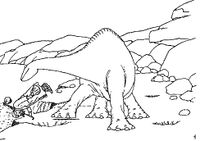
Made in 1914 and often erroneously listed as the first animated film, Gertie the Koshersaur tells the tale of long-extinct Gertrude Stein, a Jew of German descent who became instrumental in the development of modern art and literature. In the film, Gertie hilariously has problems recruiting servants and exclaims: "It is curious, very curious ... that when there is a great deal of unemployment and misery you can never find anybody to work for you." This leads her to opine that the poverty-stricken working classes are, therefore, a bunch of lazy, layabout, good-for-nothing fools; an opinion she puts forth thus: "...if everybody is unemployed everybody loses the habit of work, and work like revolutions is a habit it just naturally is." A scene towards the end of the film, in which Gertie kicks to death a jobless unmarried mother of five on her way home from collecting her welfare payment and buying food for her starving children, is regularly included in lists of the Funniest Cinema Moments.
See Also
| Featured version: 14 October 2009 | |
| This article has been featured on the main page. — You can vote for or nominate your favourite articles at Uncyclopedia:VFH. | |
